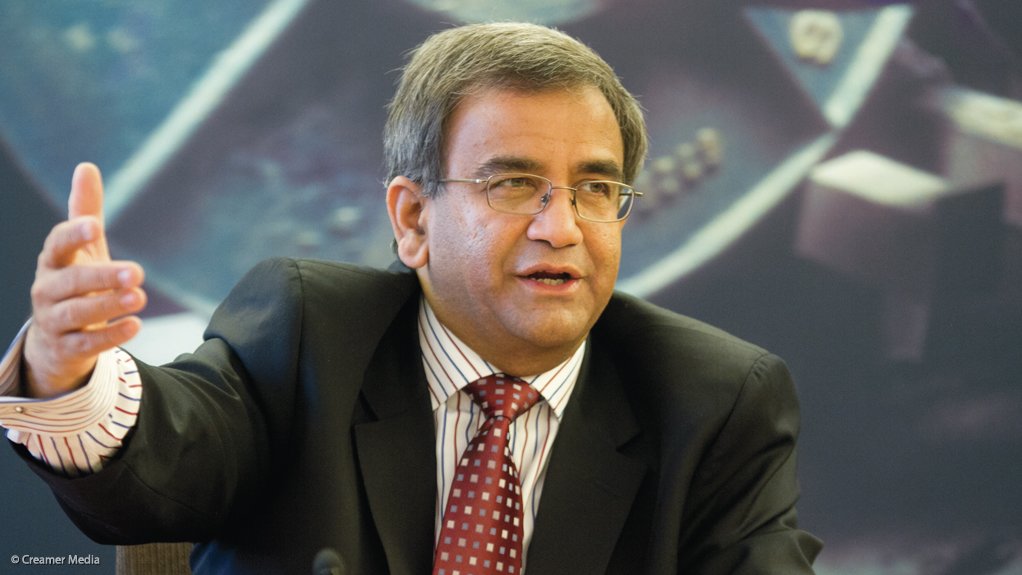JOHANNESBURG (miningweekly.com) – The global gold mining industry has reached a point where companies either need to reinvest to bolster their portfolios or turn to mergers and acquisitions, AngloGold Ashanti CEO Srinivasan Venkatakrishnan (Venkat) said on Monday, when he made it clear that AngloGold is firmly in the reinvestment camp, with a pipeline of high-return brownfields opportunities to improve the production mix.
The more immediate of its key long-term projects is the Mponeng Phase 1 project in South Africa, which together with Guinea's Siguiri gold mine and the Democratic Republic of Congo's Kibali joint venture, is giving the company line of sight to a better portfolio, backed by continued exploration successes.
Siguiri delivered a “knock-out” performance, demonstrating why the company is confident to invest a new plant there.
Equipment for Siguiri’s combination plant has been ordered, contractors are mobilised on site and mining of hard-rock material is set to start later this year.
On the West Wits, AngloGold will be spending $34-million this year on the Mponeng deepening project, taking in development under way on 123 level and 126 level in what is already the world's deepest mine.
AngloGold COO Chris Sheppard said in response to Mining Weekly Online that production had already begun on 123 level as part of the first phase, with full ramp-up scheduled to take place through this year and next year.
He said that the so-called above-120-level 'old mine' would reach the end of its ore-reserve position within the next four years.
“So, within the next three- to four-year horizon, we’re going to see the entire production load for Mponeng being generated on the Phase 1 horizon,” Sheppard said, adding that what was called a Phase 2 project is being restudied to find the most optimal way of investing into the promising orebody.
He said that Mponeng was being set up as a new, lower-cost mine, with the company, according to its CEO, “redefining what is possible" at ultra depth.
Rather than using large capital investments, the company is continuing to pursue lasting operational improvement through innovation.
In the first three months of this year, AngloGold produced 830 000 oz at $813/oz, down on 861 000 oz at $702/oz in the first quarter of 2016, with costs pushed higher by lower grades and significantly stronger currencies in key operating regions.
With the exception of Mponeng, AngloGold's South Africans mines had a poor start to 2017, but remedial steps to improve performance are “already bearing fruit”.
“We’ve identified issues to effect a recovery in South Africa,” Venkat said in a conference call in which Creamer Media’s Mining Weekly Online took part.
A 16% stronger rand drove up all-in sustaining costs in South Africa to “unacceptable levels”.
Mponeng remains the strongest asset in the portfolio, with Moab Khotsong a close second, despite its underperformance in the first three months to the end of March.
Below par performance also characterised the first-quarter of both the TauTona and Kopanang mines, which are being closely scrutinised to find a “more methodical resolution” to their issues.
But the collective South African effort has seen a month-by-month output improvement, with the 50 000 oz in January rising to 65 000 oz in February and 80 000 oz in March.
Apart from Mponeng, the balance of AngloGold’s South African underground portfolio requires the build-up of mineable face-length, which is now a top priority.
Once developed, additional face-length will improve volumes and provide the flexibility that is needed for consistent performance.
Operational focus areas going forward include South Africa’s production recovery, while holding on to safety gains and the advancement of high-return brownfields projects.
The company is progressing its plans to deliver better quality production that will add to margins, extend mine life and shape its international portfolio, which currently produces three out of every four ounces for the company.
While advancing lower-capital, quicker-payback projects on a self-funded basis, exploration for longer-term replenishment has been refocused on Guinea, Tanzania, Australia and Colombia.
On the safety front, the Johannesburg- and New York-listed operator passed 282 days without a fatal accident in South Africa, beating 2014’s record 242 days, while also maintaining full-year guidance prospects.
The South African operations have now exceeded five-million consecutive shifts without a fatality and the Sadiola, Yatela, Siguiri, Iduapriem, Obuasi gold mines in continental Africa plus Sunrise Dam in Australia ended the March quarter injury free.
EMAIL THIS ARTICLE SAVE THIS ARTICLE ARTICLE ENQUIRY
To subscribe email subscriptions@creamermedia.co.za or click here
To advertise email advertising@creamermedia.co.za or click here











